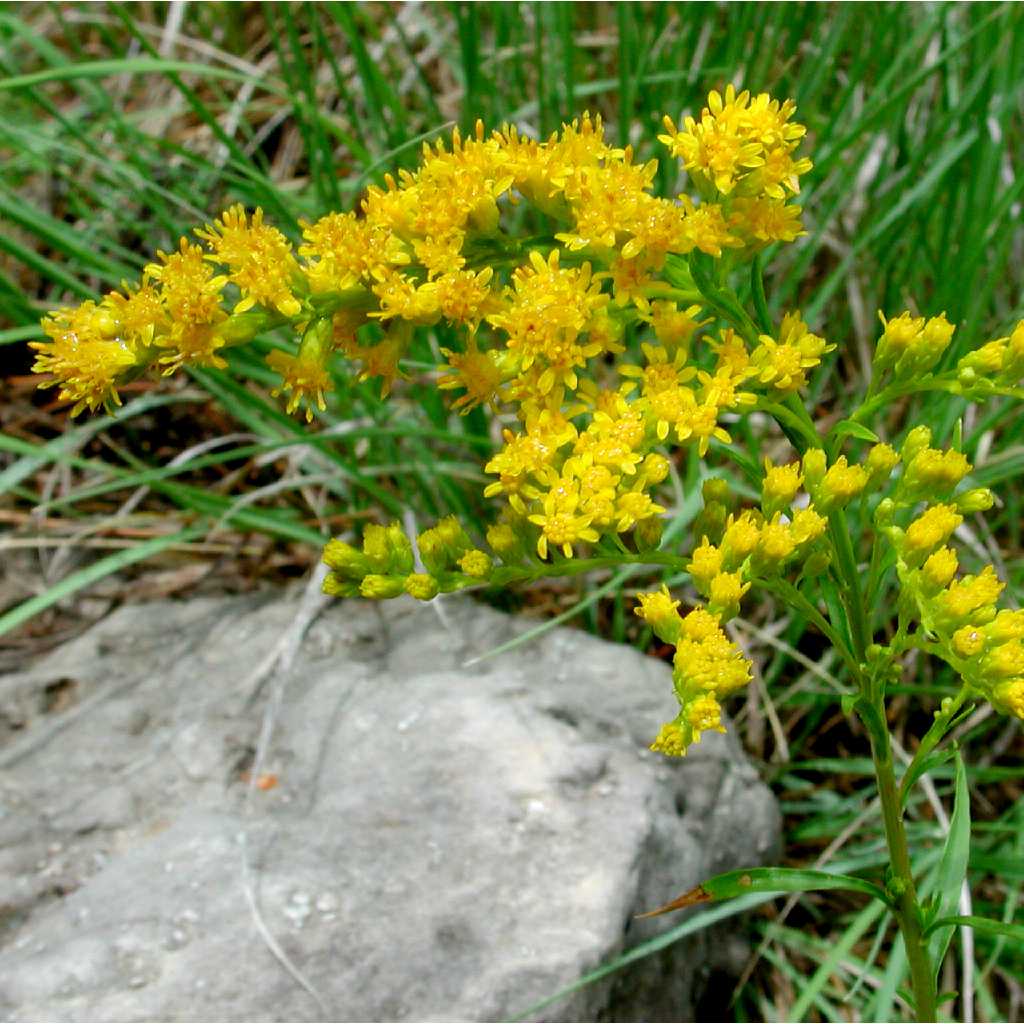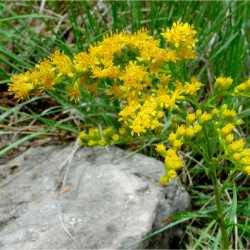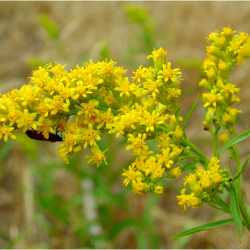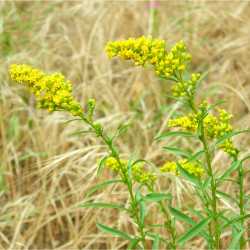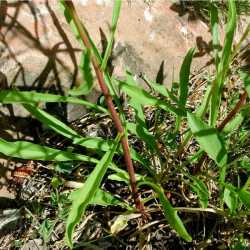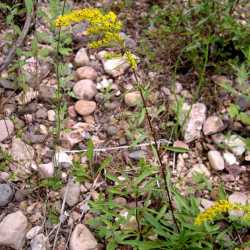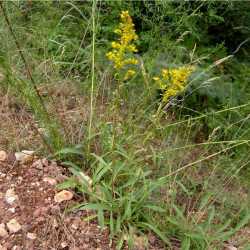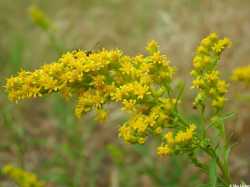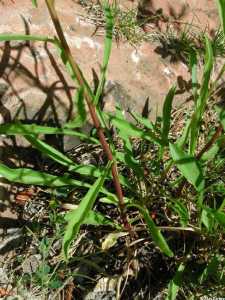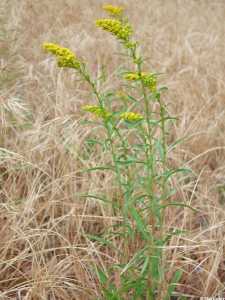Plants (10-)30-80 cm; rhizomes short to long. Stems 1-50+, erect, glabrous or sometimes sparsely strigose in arrays; fascicles of small lateral branch leaves often present in axils. Leaves: proximal cauline tapering to long, winged petioles, blades oblanceolate to linear-oblanceolate, 50-100(-200) (including petiole) × (5-)10-20(-30) mm, margins entire to serrulate, usually 3-nerved (2 larger lateral nerves), apices acute, mucronate to acuminate and somewhat spinulose, glabrous; mid to distal cauline sessile, blades lanceolate to linear, 40-60 × (2-)4-14 mm, rapidly reduced distally, margins entire, ciliate, faces glabrous. Heads 10-210 in paniculiform arrays, broadly secund-pyramidal or more rhombic to transversely rhombic, (1.5-)3-12(-20) × (1.5-)3-12 cm; branches glabrous with secund heads spreading and arching, sometimes ascending with non-secund heads. Peduncles 1.4-5 mm, glabrous or sparsely strigose; bracteoles 0-3+ , linear to lanceolate. Involucres narrowly to broadly campanulate, 2.5-4.5 mm. Phyllaries in 3-4 series, strongly unequal, margins ciliate-fimbriate, especially apically; outer ovate to lanceolate, acute to rounded, inner linear-ovate to oblong or linear-lanceolate, obtuse to rounded. Ray florets 5-14; laminae 1.5-2(-4) × 0.2-0.5(-0.75) mm. Disc florets (6-)8-20; corollas (2-)3-4 mm, lobes 0.4-1 mm. Cypselae (obconic) 1-2 mm, glabrous or sparsely strigose; pappi 2.5-3 mm. 2n = 18, 36.
Flowering (Jul-)Aug-Oct. Open sandy and rocky soils, clay soils, prairies, grasslands, pastures, open conifers forests in foothills and proximal elevations of mountains, sandstone ledges, limestone glades, disturbed soils, roadsides; 200-2200+ m; Alta., B.C., Man., Ont., Sask.; Ariz., Ark., Colo., Idaho, Ill., Ind., Kans., Ky., Mich., Minn., Mo., Mont., Nebr., Nev., N.Mex., N.Dak., Okla., Oreg., S.Dak., Tenn., Tex., Utah, Wash., Wyo.; Mexico (Coahuila).
Solidago missouriensis was often introduced along railroad lines farther east. It is a highly variable species. In the east, it can be similar to S. juncea and is not always easily distinguished where ranges overlap. In the west, it can similar to smaller plants of S. spectabilis. It is distinguished from the related species by its usually 3-nerved proximal leaves and the usually thin, elongate rhizomes. Across the prairies the species is known to be diploid only (2n = 18). In the Rocky Mountains, tetraploids (2n = 36) are common, the diploids infrequent.
A number of varieties have been described. Shorter, often larger-headed plants (tetraploids when known) from the Rocky Mountains have been treated as var. missouriensis (including var. extraria). Taller, more leafy-stemmed plants, mostly from the eastern half of the range, but occasionally west to Washington, have been treated as var. fasciculata. Plants from Arizona, Colorado, and New Mexico with long, linear leaves have been treated as var. tenuissima. Larger-headed plants with narrow bracts from prairies west of the Cascades in Oregon and Washington have been treated as var. tolmieana. A. Cronquist (1994) opted not to recognize varieties, noting that all appeared to grade continuously into each other. A detailed study of the species is needed.
Local and restricted to the prairie area of the state. It is generally found in colonies because it suckers freely from the roots as does Solidago juncea. This is a perplexing species to name because it closely resembles four other species. The original description calls for smooth plants with 3-nerved, serrulate leaves that are shining-punctate below. This species is much like small specimens of Solidago juncea but differs in being glabrous throughout, in having leaf margins sharply serrate; and in having the upper leaves more crowded and elongate. It differs from Solidago missouriensis Nutt. in having the branches of the inflorescence spreading or recurving instead of being erect. Solidago moritura Steele differs in that the leaves are not triple-nerved, at least the lateral nerves, if present, are short and faint.
Duration: Perennial
Nativity: Native
Lifeform: Forb/Herb
General: Herbaceous perennials, to 80 cm tall, stems erect, herbage glabrous or sparsely strigose throughout, fascicles of small lateral branch leaves often present in the axils, plants with short to long rhizomes.
Leaves: Alternate, basal and lower cauline leaves 4-7 cm long, on winged petioles of about the same length, blades oblanceolate to spatulate, apices acute, mucronate to acuminate and somewhat spinulose, mid to distal cauline leaves lanceolate to linear, on short petioles or sessile, leaf surfaces glabrous, becoming reduced distally, with entire, ciliate margins.
Flowers: Heads small, numerous, radiate, rays yellow, 5-14, laminae 1.5-2 mm, rays pistillate, disk flowers yellow, 8-20, perfect, involucres 3-5 mm high, narrowly to broadly campanulate, 2.5-4.5 mm high, phyllaries oblong, thin and dry with small, green tips, unequal, overlapping in 3-4 series, heads occurring mostly on one side in a broad, rounded or flat-topped panicle.
Fruits: Achenes obconic, 1-2 mm long, hairy to glabrous. Pappus of capillary bristles 2.5-3 mm.
Ecology: Found on sandy, rocky, and clay soils, in prairies, grasslands, pastures, open conifer forests in foothills and proximal elevations of mountains, sandstone ledges, limestone glades, disturbed areas, roadsides, and along streams, from 650-9,000 ft (182-274
Distribution: Michigan and Tennessee to British Columbia, Oregon, and Arizona.
Ethnobotany: Unknown, but other species in the genera have uses.
Etymology: Solidago comes from Latin solido, meaning to make whole or heal, while missouriensis means of or from Missouri.
Synonyms: Many, see Tropicos
Editor: LCrumbacher 2011
Plants (3-)5-10 dm from creeping rhizomes, sometimes with a caudex as well, glabrous throughout; lvs firm, strongly triple-nerved (at least the middle and lower), entire or some (especially the lower) serrate, the lowest ones oblanceolate and conspicuously serrate but mostly soon deciduous, the others slightly to strongly reduced upward, lance-elliptic to broadly linear, tapering to a sessile or obscurely petiolar base, often with axillary fascicles of much reduced lvs; infl paniculiform, with ±strongly recurved-secund branches, mostly short and broad; invol 3-5 mm, its bracts firm, broadly rounded to occasionally acutish; rays 7-13; disk-fls 8-13; receptacle commonly with some bracts near the margin as in no. 25 [Solidago juncea Aiton]; achenes glabrous or sparsely hairy; 2n=18, 36. Prairies and other dry, open or sparsely wooded places; widespread in w. U.S., entering our range from Minn. to Mo., and locally e. to nw. Ind. and s. Ont. Our plants, as here described, are var. fasciculata Holz. (S. glaberrima; S. moritura)
Gleason, Henry A. & Cronquist, Arthur J. 1991. Manual of vascular plants of northeastern United States and adjacent Canada. lxxv + 910 pp.
©The New York Botanical Garden. All rights reserved. Used by permission.


